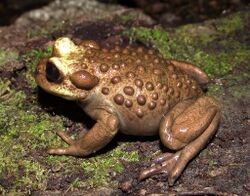Biology:Calyptocephalellidae
| Calyptocephalellidae | |
|---|---|

| |

| |
| Calyptocephalella gayi above, Telmatobufo bullocki below | |
| Scientific classification | |
| Domain: | Eukaryota |
| Kingdom: | Animalia |
| Phylum: | Chordata |
| Class: | Amphibia |
| Order: | Anura |
| Clade: | Australobatrachia |
| Family: | Calyptocephalellidae Reig, 1960 |
| Genera | |
The Calyptocephalellidae are a family of toads (although not true members of the Bufonidae) found in Chile containing two living genera, Calyptocephalella and Telmatobufo.
The genus Calyptocephalella contains one living species, the helmeted water toad (C. gayi), which is very large and mostly aquatic. The genus Telmatobufo contains four species, T. australis, T. bullocki, T. ignotus, and T. venustus.[1] All five living species within the family are considered threatened, with T. bullocki and T. venustus being classified as critically endangered.[2]
The family has been present in southern South America since the Late Cretaceous[3] and were present in the Antarctic Peninsula during the Eocene.[4] While originally widespread in Patagonia east of the Andes, they later became extinct in this region after the Late Miocene, likely due to increasingly cold and arid conditions.[5] A particularly large indeterminate fossil species is known from the Eocene of southern Chile.[6]
They are the sister group to the superfamily Myobatrachoidea, which inhabits Australasia; the ancestors of Myobatrachoidea likely diverged from Calyptocephalellidae in South America, but migrated south to Australasia via then ice-free Antarctica. Together, these groups comprise the clade Australobatrachia.[7]
References
- ↑ Frost, Darrel R. (2013). "Calyptocephalellidae, Reig 1960". Amphibian Species of the World 6.0, an Online Reference. American Museum of Natural History. http://research.amnh.org/vz/herpetology/amphibia/Amphibia/Anura/Calyptocephalellidae. Retrieved 19 September 2014.
- ↑ Donoso, Denise S.; Corres, Claudio Q.; Henriquez, Paula; Lagos, Nicolas F.; Mendez, M.A. (2010). "Amphibia, Anura, Calyptocephalellidae, Telmatobufo bullocki Schmidt, 1952: Distribution extension, habitat use and geographic distribution map.". Checklist, Journal of Species Lists and Distribution 6 (2): 298–300. http://www.checklist.org.br/getpdf?NGD136-09. Retrieved 2014-09-19.
- ↑ Novas, Fernando; Agnolin, Federico; Rozadilla, Sebastián; Aranciaga-Rolando, Alexis; Brissón-Eli, Federico; Motta, Matias; Cerroni, Mauricio; Ezcurra, Martín et al. (2019). "Paleontological discoveries in the Chorrillo Formation (upper Campanian-lower Maastrichtian, Upper Cretaceous), Santa Cruz Province, Patagonia, Argentina". Revista del Museo Argentino de Ciencias Naturales 21: 217–293. doi:10.22179/revmacn.21.655. ISSN 1514-5158.
- ↑ Mörs, Thomas; Reguero, Marcelo; Vasilyan, Davit (2020-04-23). "First fossil frog from Antarctica: implications for Eocene high latitude climate conditions and Gondwanan cosmopolitanism of Australobatrachia" (in en). Scientific Reports 10 (1): 5051. doi:10.1038/s41598-020-61973-5. ISSN 2045-2322. PMID 32327670.
- ↑ Agnolin, F. A new Calyptocephalellidae (Anura, Neobatrachia) from the Upper Cretaceous of Patagonia, Argentina, with comments on its systematic position. Stud. Geol. Salamanticensia 48, 129–178 (2012).
- ↑ Otero, R.A.; P. Jimenez-Huidobro; S. Soto-Acuña; R.E.Yury-Yáñez (2014). "Evidence of a giant helmeted frog (Australobatrachia, Calyptocephalellidae) from Eocene levels of the Magallanes Basin, southernmost Chile". Journal of South American Earth Sciences 55: 133–140. doi:10.1016/j.jsames.2014.06.010.
- ↑ Feng, Yan-Jie; Blackburn, David C.; Liang, Dan; Hillis, David M.; Wake, David B.; Cannatella, David C.; Zhang, Peng (2017-07-18). "Phylogenomics reveals rapid, simultaneous diversification of three major clades of Gondwanan frogs at the Cretaceous–Paleogene boundary" (in en). Proceedings of the National Academy of Sciences 114 (29): E5864–E5870. doi:10.1073/pnas.1704632114. ISSN 0027-8424. PMID 28673970.
Wikidata ☰ Q55457 entry
 |

